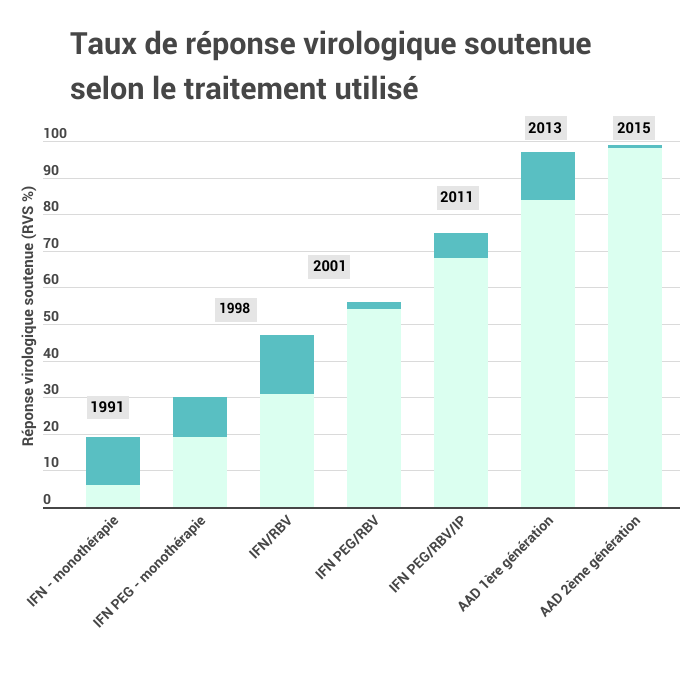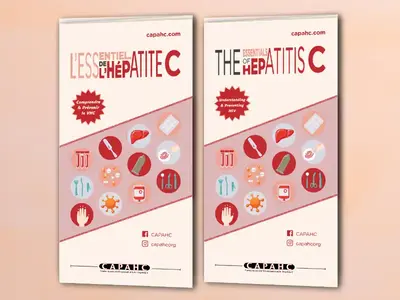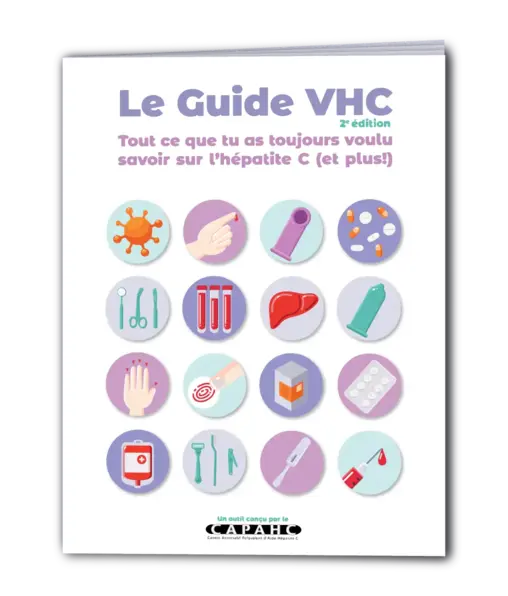Your reference for hepatitis C in Quebec
Hepatitis C treatments
Hepatitis C treatment: Hepatitis C treatment: Hepatitis C is the first chronic viral infection to be curable in humans thanks to effective modern therapies..
Interferons are an antiviral therapy and were the first molecule used for treating hepatitis non-A non-B, the original way by which hepatitis C was referred to prior to its discovery. During a primary study, interferon therapy was administered to patients for 12 months and researchers observed a significant decrease of transaminases in the serum of the patients. This began an era of interferon therapy as the primary treatment despite its efficacy rate of only 40%. A patient with sustained virological response (SVR) 24 weeks after ending treatment was considered as cured.
Introduction of ribavirin
In 1998, a second antiviral, ribavirin, was combined with interferons in HCV treatment, which increased its efficacy and resulted in an elevated SVR.

Hepatitis C treatment: Pegylated interferons (2001-2011)
The next advance in HCV treatment was marked by the use of pegylated interferons (longer lasting) in 2001. More efficient and simpler to administer (only requiring one dose per week), pegylated interferon therapy allowed for better monitoring of patients. This new combination led to SVR in 55% of cases.
Decryption of the HCV life cycle led to the development of a new generation of antiviral treatment: direct-acting antivirals (DAA). These new molecules directly targeted certain viral proteins necessary for HCV’s replication. The first DAAs developed, Boceprevir and Telaprevir, were protease inhibitors. Their function was to prevent the HCV polyprotein from splicing between NS3 and NS4A. In 2011, they were approved as a treatment for HCV.
Adding protease inhibitors to the Peg-IFN–RBV combination increased the rate of SVR by 30% in treatment-naive patients and reduced the amount of time required for treatment. With this treatment combination, however, health risks have been observed along with increased side effects. New treatments are expected.
Hepatitis C treatment: Interferon-free treatment (2013)
Considering the secondary effects and limitations of interferon-based treatment, it became necessary to develop new interferon-free treatments. The development of NS5A inhibitors has marked a substantial step forward. In 2012, a primary study showed the possibility of treating HCV without interferons (Lok, 2012).
Sofosbuvir was the first interferon-free therapy to be approved. In general, it has few side effects and is well tolerated by most patients. High SVR rates were documented after only 12 weeks of treatment for treatment-naive patients, which represents a drastic change.
Simeprevir and daclatasvir have been used for genotypes 1 and 3. In the COSMOS randomized study, patients treated with a combination of simeprevir and daclatasvir achieved SVR rates of 90-92% following periods of treatment lasting 12 to 24 weeks.
New studies published in 2014 demonstrated the efficacy of DAA combinations. The rate of SVR for genotype 1 carriers were reported at 95%.
Hepatitis C treatment: Pangenotypic treatments
One of the latest advances in treating HCV, velpatasvir, arrived in 2016. A second generation pangenotypic NS5A inhibitor, velpatasvir is administered in combination with sofosbuvir for treating HCV. According to one study, a cohort of patients achieved an SVR of 99% independent of genotype over a period of 12 weeks. For patients who have already undergone some form of treatment (non-treatment-naive), SVR rates were lower (93% among patients with cirrhosis and 89% among those without).
En 2017, la combinaison glecaprevir- pibrentasvir est approuvée. Elle est très bien tolérée et atteint des taux de RVS similaires. Les patient·es porteur·euses d’un génotype 1, 2, 4, 5 ou 6 et naïf·ves au traitement ont des RVS atteignant 97 % à 100 % en 8 semaines. Des études sont en cours pour envisager une diminution du temps de traitement chez les personnes ayant contracté le VHC récemment. La plupart de ces études démontrent que les AAD perdent de leur efficacité si la durée de traitement devient inférieure à 8 semaines..

Prior to treatment, the doctor will perform an initial assessment that includes diagnosis, medical history (lifestyle, medication history), clinical examination, biological testing, and determination of fibrosis stage. Genotyping is not mandatory to start treatment unless it can influence it. It is important to consider the psychosocial aspects of the patient (RAMQ card, risk of imprisonment, income: access to transport, food, etc.) and physical health (prevention of reinfection, risk of overdose, etc.).
The patient should receive information orally and in written form along (more information available here) ,with the medical follow-up
It is important to note any medications taken for preventing drug interactions and to verify contraception (cf. HCV and pregnancy).
During treatment, a blood test is conducted to determine the quantitative RNA at week four (in case of doubt concerning treatment adherence), but this result does not predict treatment success.
At 12 weeks into treatment, SVR testing takes place involving another blood test (viral load and ALT) to assess treatment response.
The WHO’s latest strategy for eliminating viral hepatitis recommends simplifying treatment:
- Offering decentralized services (for example, rapid tests at points of service);
- Eliminating unnecessary appointments (for example, implementation of REFLEX tests);
- Elimination non-obligatory tests (for example, Fibroscan at a score of Fib-4, genotyping…).
Missed doses
Missing a dose of DAA is relatively common. Most of the time, doses are missed for only short periods of time. According to available data, it is estimated that an interruption of treatment of less than seven days does not have a significant chance of impacting SVR level. However, longer periods can certainly reduce efficacy of the treatment. Recommendations have been formulated in cases of non-adherence to the treatment, see hcvguidelines.org..
The effects of drug interactions are typically undesirable and sometimes harmful. Interactions may include:
- An increase of effects, leading to side-effects or toxicity;
- Diminish effects, rendering the treatment less effective.
Certain DAAs can interact with other treatments such as acid-reducing agents (which affects their absorption) or amiodarone (a medication that prevents and treats arrhythmia), which can lead to a risk of severe bradycardia when taken with sofosbuvir. Tools are available for evaluating drug interactions, see hep-druginteractions.org.
Beyond interactions with medications, there can be other severe interactions with natural health products. Certain hepatotoxic plants can harm the liver. Others are falsely reputed to have hepatoprotective effects on the liver or to ward off HCV.
It is important to note that no study to date has demonstrated the efficacy of medicinal plants for protecting against or curing HCV. Furthermore, certain plants may interfere with DAAs such as St. John’s wort, which reduces their concentration.7 Health professionals should be informed of all medications and natural products consumed by their patients.
Since 2018, access to DAAs is universal in Quebec for people living with hepatitis C, regardless of their fibrosis stage or if they have medical insurance (RAMQ or PFSI).
Numerous obstacles do, however, remain in regards to accessing screening and treatment. For example, stigmatization, racism and institutional or structural discrimination faced by key populations affected by HCV may dissuade people from seeking services.
Certain factors, such as judicialization, criminalization, poverty, and the precariousness of at-risk communities, create a coercive environment in which people prioritize survival and ultimately relegate health concerns to a lower level of importance. In addition, the criminalization of drug use hinders STBBI prevention efforts.
Living in situations of homelessness and having restricted means of communication are also factors to consider for assuring access to care associated with HCV.
Considering the impact of the COVID-19 pandemic on access to care in general, the healthcare system in Quebec itself can be considered an obstacle to accessing care. The wait-time for getting a family doctor is several years, blood tests take weeks… And, even though the WHO implemented recommendations for simplifying and decentralizing care to fight against STBBIs, screening remains only practicable by doctors and nurses in Quebec. As such, community workers are unable to be trained to offer rapid tests at points of service. Finally, the lack of knowledge about HCV among many doctors is also an obstacle. The goal of the instructional video program ÉCHO du CHUM hépatite C et problématiques des troubles de l’usage is to increase HCV testing rates, evaluation and treatment by informing first and second-line health professionals about best-practices related to HCV, especially in remote regions.
Hepatitis C can be treated and cured, but people do not develop immunity to the virus. This means that reinfection with HCV is possible. The risk of infection is highest among people who consume drugs (especially for recent consumption and consumption via injection) and people living with HIV/HCV coinfection.8
Among PWUD, age is the highest risk factor associated with reinfection (those under 30 are at greater risk) and opioid consumption. On the other hand, a lowered risk has been observed for people undergoing opioid agonist therapy (OAT), people who have access to mental health support, and people who take antipsychotic treatments as indicated. In order to prevent reinfection, it is important to promote harm reduction services (distribution of sterile equipment for consumption, supervised consumption sites, OAT, safe supply, Naloxone…), provide adapted ways of informing and educating people, and facilitate access to screening for concerned communities.





